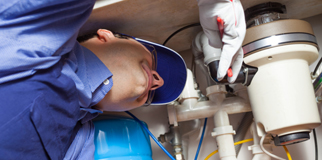Your Comprehensive Guide to Fixing a Leaky Garbage Disposal
Your Comprehensive Guide to Fixing a Leaky Garbage Disposal
Blog Article
How do you actually feel about The Handy Guide To Fixing Your Garbage Disposal Leaking?

Garbage disposals are important kitchen area appliances that assist in dealing with food waste effectively. However, a dripping waste disposal unit can be a frustrating and unpleasant trouble to take care of. Fortunately, many leakages can be repaired conveniently with a couple of straightforward steps. In this article, we will talk about exactly how to take care of a leaking waste disposal unit properly.
Introduction
Waste disposal unit are set up under cooking area sinks and are made to shred food waste into smaller sized pieces, enabling it to travel through the plumbing system easily. While these gadgets are normally reliable, leaks can happen in time because of wear and tear, loose connections, or damage to the system.
Typical Causes of Leaks in Trash Disposals
Worn Seals and Gaskets
Seals and gaskets play an important function in avoiding water from leaking out of the waste disposal unit. Over time, these components can deteriorate, resulting in leaks around the disposal device.
Loose Links
The links between the garbage disposal and the pipes system can come to be loosened gradually, causing water to leakage out throughout operation.
Cracks or Holes in the Disposal Unit
Physical damages to the waste disposal unit, such as splits or holes in the real estate, can also result in leaks.
Identifying the Source of the Leakage
Prior to attempting to take care of a dripping waste disposal unit, it is vital to recognize the resource of the leakage. This can generally be done through aesthetic examination or by carrying out basic tests.
Visual Inspection
Evaluate the garbage disposal unit very carefully for any indicators of water leak. Pay close attention to locations around seals, gaskets, and connection factors.
Evaluating for Leakages
One method to test for leakages is by running water with the disposal unit and looking for any type of noticeable signs of leak.
Tools and Products Needed for Fixing a Dripping Waste Disposal Unit
Prior to beginning the repair process, collect the essential devices and products, consisting of a screwdriver, adjustable wrench, plumbing professional's putty, substitute seals or gaskets, and epoxy or patching product for fixing fractures or holes.
Step-by-Step Overview to Taking Care Of a Dripping Garbage Disposal
Turn Off the Power
Prior to attempting any repair work, ensure that the power to the waste disposal unit unit is switched off to avoid the danger of electrical shock.
Find the Leak
Identify the specific place of the leak and identify the cause.
Tighten up Connections
Use a wrench to tighten up any kind of loose links in between the disposal unit and the plumbing system.
Change Seals or Gaskets
If the leak is due to used seals or gaskets, remove the old elements and change them with new ones.
Patching Splits or Holes
For splits or openings in the disposal unit, usage epoxy or an ideal patching material to seal the damaged location.
Testing the Garbage Disposal After Repair Service
When the repair is total, examine the garbage disposal by running water via it to make sure that the leak has been fixed.
Preventive Maintenance Tips to Stay Clear Of Future Leakages
To avoid future leaks, it is necessary to perform normal upkeep on your waste disposal unit. This includes keeping it tidy, staying clear of placing non-food products or difficult items down the disposal, and periodically checking for leaks or other issues.
Conclusion
In conclusion, repairing a leaking garbage disposal is a fairly simple process that can be finished with standard devices and materials. By following the actions detailed in this post and exercising precautionary maintenance, you can maintain your garbage disposal in good working problem and stay clear of expensive fixings in the future.
HERE’S HOW TO FIX YOUR GARBAGE DISPOSAL
WHAT TO DO IF SOMETHING IS STUCK IN YOUR GARBAGE DISPOSAL
If the impeller won’t turn, there’s probably something stuck in the disposal. It could be a steak bone or peach pit, although plumbers report pulling all sorts of inappropriate objects out of disposals, such as bottle caps or aluminum foil. Make sure power to the disposal is off, and look inside to see if you can see the source of the jam.
Never stick your fingers in a disposal. Pull out anything you see with tongs or pliers.
If the disposal still won’t work, it may be time to call a plumber or consider buying a new disposal. GEM Plumbing & Heating is here for all of your garbage disposal needs.
WHAT TO DO IF YOUR GARBAGE DISPOSAL DRAIN IS CLOGGED
Take everything out from underneath your sink and put a bucket or other container under your disposal to catch any water that drains out. Disconnect your disposal from the power supply. If it’s plugged into a wall outlet, unplug it. If it’s hardwired into an electrical box, go to the electrical panel and turn off the breaker for the disposal. Pour ¼ cup of baking soda into the drain, followed by ½ cup of white vinegar. Give the solution a few minutes to fizz and do its work. Look into the disposal with a flashlight to see if you can see an object that might be causing the clog. If you see it, remove it using tongs or pliers. MORE TIPS ON DEALING WITH A CLOGGED GARBAGE DISPOSAL
Never use drain cleaner in a garbage disposal. It can damage the plastic parts inside the disposal. You can also be splashed with the caustic liquid while working to clear the clog. Beware! Never stick your fingers into a garbage disposal. Trust us — not a good idea. In many instances, your dishwasher drains through your garbage disposal. This allows the disposal to grind any large food particles that may be drained out of your dishwasher. There are some jurisdictions, however, where the plumbing code prohibits such a connection. WHAT TO DO WHEN YOUR DISHWASHER DRAINS THROUGH THE DISPOSAL
Run some water in the sink so your plunger has at least a ½-inch of water to create a seal and plunge vigorously up and down several times. You may need to repeat this several times. Run hot water down the drain to clear any residue that remains.

As a person who reads on Why Is My Garbage Disposal Leaking From the Bottom?, I think sharing that piece of writing was a smart idea. Do you know somebody else who is in to the niche? Be sure share it. Thank-you for your time spent reading it.
Call Today Report this page